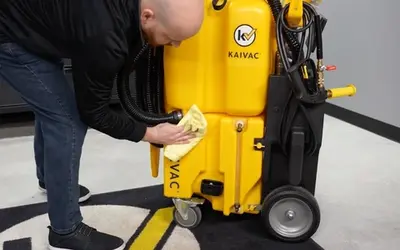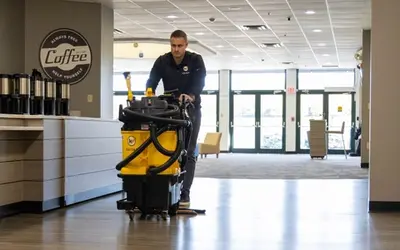Kennel Cleaning to Keep Pets, and Pet Businesses, Healthy

Proper kennel cleaning helps keep dogs healthy and safe. In the U.S. over 65 million households own a dog (although “own” may not be the right word as 97% of pet owners consider their pets part of the family). And, just like any family member, health and comfort are usually top of mind for the pet parents in charge, especially when it comes to boarding and daycare. Pet business owners should take note.
“How your business looks and smells are two of the top criteria pet owners use when choosing a daycare or boarding facility,” writes Chris Quinlan in Pet Boarding & Daycare magazine. But good kennel cleaning practices are more than cosmetic. A well-considered kennel cleaning protocol also protects pets from highly contagious illnesses.
Kennel Cough, A Common Complaint
There are many disease risks for dogs in social settings, but kennel cough is especially pernicious.
Kennel cough, also known as tracheobronchitis or Bordetella bronchiseptica, can be found nearly everywhere. The upper respiratory, highly contagious infection is airborne, spread by droplets secreted by other infected canines. Healthy dogs breathe in the droplets, touch noses with infected dogs, or interact with contaminated surfaces, toys, or food and water bowls can then get infected.
Symptoms include a persistent, goose honk-like cough, sneezing, runny nose, and eye discharge. An effective vaccine for Bordetella exists, but it takes weeks to build immunity. Thankfully the disease is rarely fatal, but it is highly contagious. That leads to suffering for the dogs, and the dog-related business.
Clean Kennels Help Prevent Diseases
Well cleaned kennels are one of the best ways to prevent kennel cough. Pet Boarding and Daycare Magazine offers the following sanitation tips:
- Clean first. Disinfectants are deactivated by dirt, so any surface should be thoroughly cleaned first.
- The Bordetella virus can live in water. Thoroughly dry surfaces after cleaning and disinfecting.
- Remove dogs from the area if power sprayers are used to clean. Sprayers can actually aerosolize infectious organisms and increase the spread of infection.
- Disinfect all enclosures, walls, floors, doors, etc.
- Disinfect bowls and toys between dogs.
- Wash bedding, towels, and uniforms in a washing machine with hot water, detergent, and bleach. Dry on a high heat cycle in the dryer.
- Spray application of disinfectants is preferred to a mop and bucket. The mop water can easily become contaminated and spread infection to other areas of the facility.
That last tip, about mops and buckets, is true for kennel cleaning as well as kennel disinfecting. In fact, with the right technology, your staff can clean and disinfect with one machine. The No-Touch Cleaning® system from Kaivac empowers workers to fully remove dirt, impurities, and dangerous pathogens from the environment. The tool is easy to use, prevents cross-contamination, and leaves surfaces safe and dry.
To be truly effective, kennel cleaning needs to be ongoing. Creating a well-thought out kennel cleaning checklist will help set tone. Be sure to pinpoint the right detergents and disinfectants, define tasks, and clarify expectations for employees. The dogs, and their doggy parents, will thank you.
Related Posts

Preventive Maintenance for Your No-Touch Cleaning® System
Your Kaivac No-Touch Cleaning system makes restroom maintenance fast and easy. Keeping your No-Touch Cleaning system in good working order is also fast and easy. Kaivac makes performing preventative maintenance and troubleshooting potential issues simple. No special equipment or technical expertise required.
Read more
A System for Every Aisle: How Kaivac Delivers Complete Grocery Store Cleaning Solutions
Kaivac’s integrated Grocery Suite streamlines cleaning across every store zone, cutting labor, reducing cross-contamination, and delivering faster, deeper hygiene results for safer, fresher stores.
Read more
How to Clean Worship Facility Floors
Worship facilities need clean, safe floors to best serve their congregations. Here’s how tools from Kaivac keep worship facilities clean from the entry to seating areas to kitchens and more.
Read more